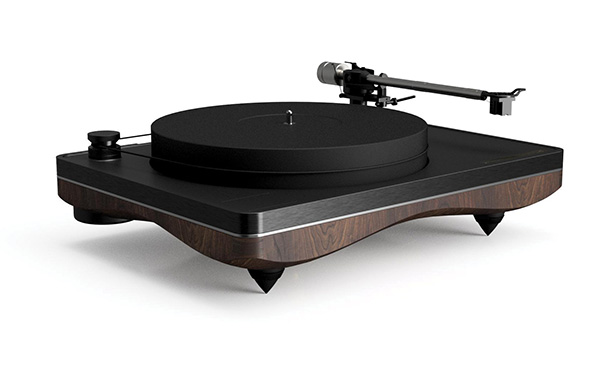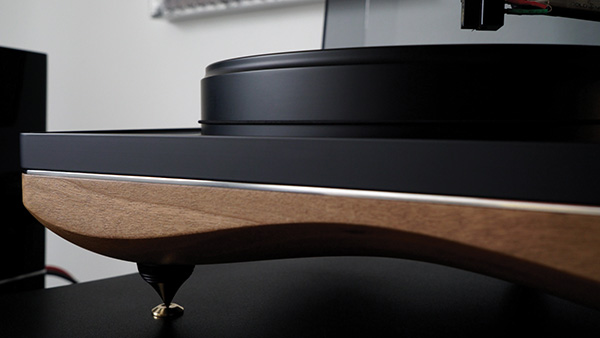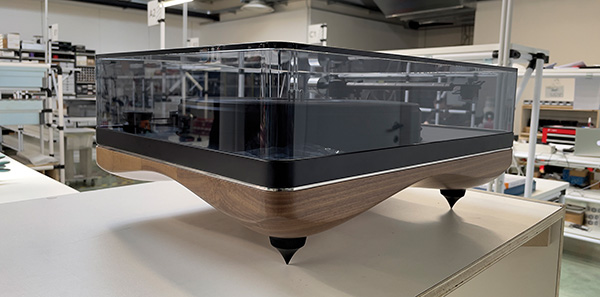| Columns Retired Columns & Blogs |
Feminine curves with great analog performance at the price point. Wish, wish, wish... Perhaps I'll be able to hear it AXPONA this April.
Nice review as well. "Bacchanalia of lascivious intent..." Wonderful!

An exploration of the artistry and expertise behind the Mediterraneo X is a journey through Italian craftsmanship.
Gold Note Founder and CEO Maurizio Aterini spearheaded the project, but the creation of the X involved the entire Gold Note team. The turntable design originated with architect Stefano Bonifazi, a consistent contributor to Gold Note products from speakers to electronics. Working with him was Product Designer Marco Attal. Mechanical engineering was handled by audio engineer Flavio Lenzi, electronic hardware by Chief Electrical Engineer David Scandagli and Senior Electrical Engineer Giovanni Rialti. Software Engineer Stefano Bellucci developed the firmware for motor control, speed adjustment, torque control, and user interface (UI).
"The idea behind the Mediterraneo X was to elevate the [original] Mediterraneo turntable in terms of performance, design, materials, and features, pushing that architecture to a new level," Gold Note Product Manager Tom Dolfi told me in an email. "At the same time, the X was the perfect playground to experiment with a new design language, introducing shapes and materials that will cascade on other turntables and are fully leveraged on the flagship model—all of this while preserving the spirit of the original Mediterraneo. Hence the name Mediterraneo X, where X is the Roman number for 10, as in our 10th anniversary as Gold Note."
A major presence in Italian audio, Gold Note has appeared in prior issues of Stereophile—in Jason Victor Serinus's take on Gold Note's DS-10 D/A processor in July 2020, Michael Fremer's review of the PH-1000 phono preamplifier in February 2022, and the same reviewer's take on the Tuscany Gold MC cartridge in February 2017. Fresh from reviewing the Gold Note PH-5 phono stage for AnalogPlanet.com, I was curious to hear more of the big Italian brand's audio offerings.

Gold medal design
The X is one quiet record player. In my informal tests, tapping, poking, or rapping on its plinth during playback caused zero vibration/rumble/noise to its cartridge/tonearm assembly. When asked what made that possible, Stefano Bonifazi replied by email.
The X's plinth "is a triple-layer architecture of materials with different densities and structures to break resonance patterns and prevent the transmission of vibrations," he wrote. "The [materials] are also shaped to be as inert (nonreactive) as possible, which is particularly visible in the bottom wood layer, designed following the principle of the catenary arch, a naturally occurring curve with high strength, stability, rigidity, and damping qualities. This type of arch was developed by Michelangelo to design the bridge of Santa Trinita in Firenze as well as by Filippo Brunelleschi to engineer the dome of the Duomo in Firenze.
"Many of the X's surfaces and planes are not actually physically connected—the platter spindle spins on a ceramic ball bearing housed underneath the wooden plinth in a custom brass nut, shielded from vibrations—or leveraged by some form of decoupling, such as elastomers applied to feet and around the motor," he continued. "Another contributing factor is the effective mass/shape combination: The mass is high but not crazy high, but the shape and the triple-layer structure enhance it so that it dampens vibrations as a much heavier object would."

That triple-layer plinth comprises a top-facing layer of aluminum, "CNC-machined from a solid block to achieve a single-piece layer," Marco Attal wrote. "The aluminum is then treated with liquid coating to prevent electrical interactions between the metal components, and to ensure the correct grounding."
"The aluminum plinth is treated by applying three layers of coating by hand, with a sequence of primer/liquid paint/clear coat," Tom Dolfi wrote. "Such a 'cocktail' serves multiple purposes other than just providing the finish and color to the plinth. It's crucial in preserving the aluminum from the effects of the environment (humidity, heat, and other agents) and—equally important—ensuring the plinth is correctly grounded so that there's no parasitic currents/capacitance in the system, but also preventing 'ghost inputs' as we call them on the unit's touchscreen display."
"The [curvaceous] bottom layer is made of Italian Walnut hardwood," Attal continued. "The hardwood undergoes a special autoclave treatment to make it inert, more resistant, and suitable for this application—especially important because our turntables can be found in all sorts of climates, from the hot and humid to the dry and cold. Finally, the two layers are joined together with a 3mm-thick slab of stainless steel."

Gold Note mounts its gimbaled, B-7 Ceramic X tonearm on the X. The B-7's wand is made of titanium and stabilized with four high-precision ceramic ball bearings manufactured by GRW of Germany. A stainless steel counterweight provides balance. Dolfi described the B-7 as a "9" straight tonearm (I-type)," but he implored that it's no knockoff. "All our tonearms are completely made and tested by hand, in-house. Each tonearm requires more than 100 individual components to be fully built."
The B-7 Ceramic's headshell uses a 6000-series aluminum alloy for resonance control. Hardwired Litz-type AWG36 cables, crafted from oxygen-free copper (OFC), ensure pure signal transmission.
"The vertical, ultralow-friction ceramic ball bearings are pivoted through stainless steel bolts," which can be adjusted manually, states a Gold Note distributor page. "The horizontal movement is driven by two micro ball bearings directly inserted in the main rectified pivot."
Two discreet, 2mm microbolts at the front of the tonearm wand allow for azimuth adjustment, while a pair of bolts embedded in the central post provide VTA control. The tonearm's antiskating bar is made of a polymeric resin, "chosen for its rigidity (Tensile and Flexural Modulus) and light weight," Attal wrote. "All the [other] parts used for the tonearm are custom made of CNC-machined aluminum and brass, including the cueing lever."

The X's platter weighs almost 16lb. Like the plinth, its construction is composite, made of aluminum and a "donut of POM ... to provide the desired mass and stability," Stefano Bonifazi wrote. The platter spins on a ceramic, 1/8" ball bearing via a carbon steel spindle set within a bronze housing.
Gold Note supplied a floppy, surprisingly thin felt mat, a curious choice for a turntable costing $12,999. "In our tests, the felt mat performs quite well," Dolfi wrote. "We used to also supply a mat in gel, which we discontinued in 2019."
The motor is one of the X's most interesting and distinctive features. "For the Mediterraneo X, we chose a variable-torque motor, which allows the listener to control the torque applied to the platter in real time and while spinning records. A high-torque setting results in a performance reminiscent of direct-drive, while a low-torque setting is more in line with the sound of the belt-drive. The motor is decoupled from the plinth through elastomers, and secured in the housing with an aluminum bracket which is also decoupled thanks to custom spacers made of resin."
The motor is supplied by Johnson Electric of Hong Kong. "We have been using their motors for turntables for years," David Scandagli said. The Johnson motor drives a belt made of EPDM. Finally, three tanklike adjustable feet are CNC-machined from solid aluminum blocks.
This is a smartly designed, handily appointed, tricked-out turntable, as robust in conception as it is beautiful. At $12,999 it isn't cheap, but its build quality and design speak to its serious intent.

Feminine curves with great analog performance at the price point. Wish, wish, wish... Perhaps I'll be able to hear it AXPONA this April.
Nice review as well. "Bacchanalia of lascivious intent..." Wonderful!

What other intent would there be for a Bacchanalia?